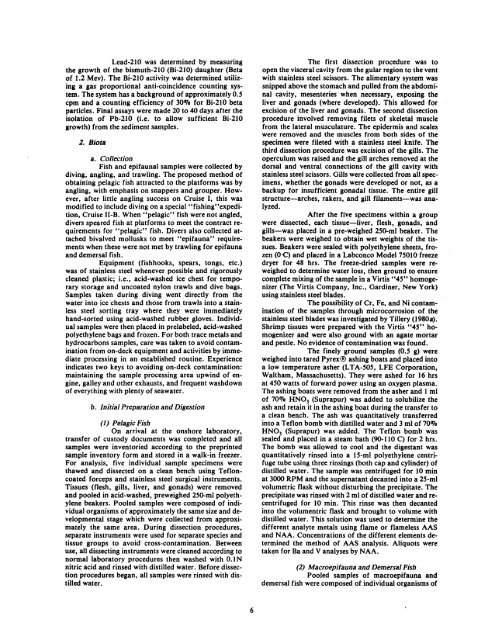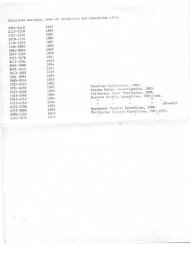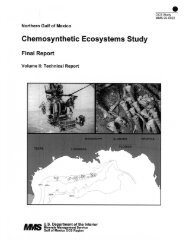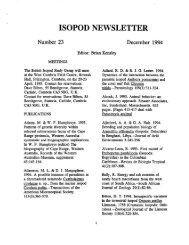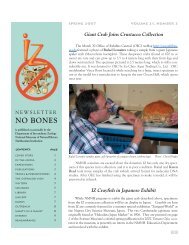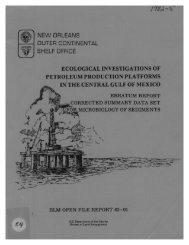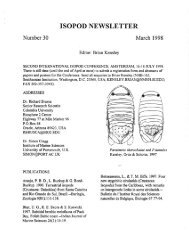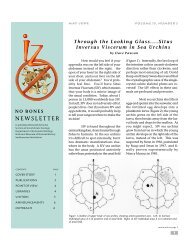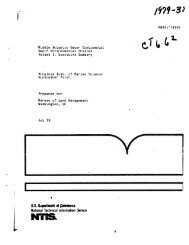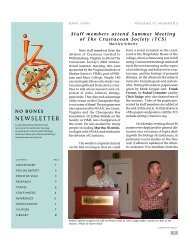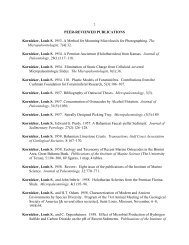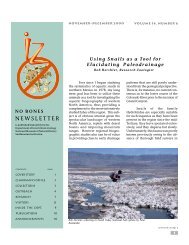Vol.1 part 4-5 - Department of Invertebrate Zoology
Vol.1 part 4-5 - Department of Invertebrate Zoology
Vol.1 part 4-5 - Department of Invertebrate Zoology
Create successful ePaper yourself
Turn your PDF publications into a flip-book with our unique Google optimized e-Paper software.
Lead-210 was determined by measuring<br />
the growth <strong>of</strong> the bismuth-210 (Bi-210) daughter (Beta<br />
<strong>of</strong> 1 .2 Mev) . The Bi-210 activity was determined utilizing<br />
a gas proportional anti-coincidence counting system<br />
. The system has a background <strong>of</strong> approximately 0 .5<br />
cpm and a counting efficiency <strong>of</strong> 30% for Bi-210 beta<br />
<strong>part</strong>icles . Final assays were made 20 to 40 days after the<br />
isolation <strong>of</strong> Pb-210 (i .e . to allow sufficient Bi-210<br />
growth) from the sediment samples .<br />
2. Biota<br />
a. Collection<br />
Fish and epifaunal samples were collected by<br />
diving, angling, and trawling . The proposed method <strong>of</strong><br />
obtaining pelagic fish attracted to the platforms was by<br />
angling, with emphasis on snappers and grouper . However,<br />
after little angling success on Cruise I, this was<br />
modified to include diving on a special "fishing"expedition,<br />
Cruise II-B . When "pelagic" fish were not angled,<br />
divers speared fish at platforms to meet the contract requirements<br />
for "pelagic" fish . Divers also collected attached<br />
bivalved mollusks to meet "epifauna" requirements<br />
when these were not met by trawling for epifauna<br />
and demersal fish .<br />
Equipment (fishhooks, spears, tongs, etc .)<br />
was <strong>of</strong> stainless steel whenever possible and rigorously<br />
cleaned plastic ; i .e ., acid-washed ice chest for temporary<br />
storage and uncoated nylon trawls and dive bags .<br />
Samples taken during diving went directly from the<br />
water into ice chests and those from trawls into a stainless<br />
steel sorting tray where they were immediately<br />
hand-sorted using acid-washed rubber gloves . Individual<br />
samples were then placed in prelabeled, acid-washed<br />
polyethylene bags and frozen . For both trace metals and<br />
hydrocarbons samples, care was taken to avoid contamination<br />
from on-deck equipment and activities by immediate<br />
processing in an established routine . Experience<br />
indicates two keys to avoiding on-deck contamination :<br />
maintaining the sample processing area upwind <strong>of</strong> engine,<br />
galley and other exhausts, and frequent washdown<br />
<strong>of</strong> everything with plenty <strong>of</strong> seawater .<br />
b .<br />
Initial Preparation and Digestion<br />
(1) Pelagic Fish<br />
On arrival at the onshore laboratory,<br />
transfer <strong>of</strong> custody documents was completed and all<br />
samples were inventoried according to the preprinted<br />
sample inventory form and stored in a walk-in freezer .<br />
For analysis, five individual sample specimens were<br />
thawed and dissected on a clean bench using Tefloncoated<br />
forceps and stainless steel surgical instruments .<br />
Tissues (flesh, gills, liver, and gonads) were removed<br />
and pooled in acid-washed, preweighed 250-m1 polyethylene<br />
beakers . Pooled samples were composed <strong>of</strong> individual<br />
organisms <strong>of</strong> approximately the same size and developmental<br />
stage which were collected from approximately<br />
the same area . During dissection procedures,<br />
separate instruments were used for separate species and<br />
tissue groups to avoid cross-contamination . Between<br />
use, all dissecting instruments were cleaned according to<br />
normal laboratory procedures then washed with O.1N<br />
nitric acid and rinsed with distilled water . Before dissection<br />
procedures began, all samples were rinsed with distilled<br />
water .<br />
The first dissection procedure was to<br />
open the visceral cavity from the gular region to the vent<br />
with stainless steel scissors . The alimentary system was<br />
snipped above the stomach and pulled from the abdominal<br />
cavity, mesenteries when necessary, exposing the<br />
liver and gonads (where developed) . This allowed for<br />
excision <strong>of</strong> the liver and gonads . The second dissection<br />
procedure involved removing filets <strong>of</strong> skeletal muscle<br />
from the lateral musculature. The epidermis and scales<br />
were removed and the muscles from both sides <strong>of</strong> the<br />
specimen were fileted with a stainless steel knife. The<br />
third dissection procedure was excision <strong>of</strong> the gills. The<br />
operculum was raised and the gill arches removed at the<br />
dorsal and ventral connections <strong>of</strong> the gill cavity with<br />
stainless steel scissors . Gills were collected from all specimens,<br />
whether the gonads were developed or not, as a<br />
backup for insufficient gonadal tissue . The entire gill<br />
structure-arches, rakers, and gill filaments-was analyzed<br />
.<br />
After the five specimens within a group<br />
were dissected, each tissue-liver, flesh, gonads, and<br />
gills-was placed in a pre-weighed 250-m1 beaker . The<br />
beakers were weighed to obtain wet weights <strong>of</strong> the tissues<br />
. Beakers were sealed with polyethylene sheets, frozen<br />
(0 C) and placed in a Labconco Model 75010 freeze<br />
dryer for 48 hrs . The freeze-dried samples were reweighed<br />
to determine water loss, then ground to ensure<br />
complete mixing <strong>of</strong> the sample in a Virtis "45" homogenizer<br />
(The Virtis Company, Inc ., Gardiner, New York)<br />
using stainless steel blades .<br />
The possibility <strong>of</strong> Cr, Fe, and Ni contamination<br />
<strong>of</strong> the samples through microcorrosion <strong>of</strong> the<br />
stainless steel blades was investigated by Tillery (1980x) .<br />
Shrimp tissues were prepared with the Virtis "45" homogenizer<br />
and were also ground with an agate mortar<br />
and pestle . No evidence <strong>of</strong> contamination was found .<br />
The finely ground samples (0.5 g) were<br />
weighed into tared PyrexO ashing boats and placed into<br />
a low temperature asher (LTA-505, LFE Corporation,<br />
Waltham, Massachusetts) . They were ashed for 16 hrs<br />
at 450 watts <strong>of</strong> forward power using an oxygen plasma .<br />
The asking boats were removed from the asher and 1 ml<br />
<strong>of</strong> 70% HN03 (Suprapur) was added to solubilize the<br />
ash and retain it in the asking boat during the transfer to<br />
a clean bench . The ash was quantitatively transferred<br />
into a Teflon bomb with distilled water and 3 ml <strong>of</strong> 70%<br />
HN03 (Suprapur) was added . The Teflon bomb was<br />
sealed and placed in a steam bath (90-110 C) for 2 hrs .<br />
The bomb was allowed to cool and the digestant was<br />
quantitatively rinsed into a 15-m1 polyethylene centrifuge<br />
tube using three rinsings (both cap and cylinder) <strong>of</strong><br />
distilled water . The sample was centrifuged for 10 min<br />
at 3000 RPM and the supernatant decanted into a 25-m1<br />
volumetric flask without disturbing the precipitate . The<br />
precipitate was rinsed with 2 ml <strong>of</strong> distilled water and recentrifuged<br />
for 10 min . This rinse was then decanted<br />
into the volumentric flask and brought to volume with<br />
distilled water . This solution was used to determine the<br />
different analyte metals using flame or flameless AAS<br />
and NAA . Concentrations <strong>of</strong> the different elements determined<br />
the method <strong>of</strong> AAS analysis . Aliquots were<br />
taken for Ba and V analyses by NAA .<br />
(2) Macroepifauna and Demersal Fish<br />
Pooled samples <strong>of</strong> macroepifauna and<br />
demersal fish were composed <strong>of</strong> individual organisms <strong>of</strong>


